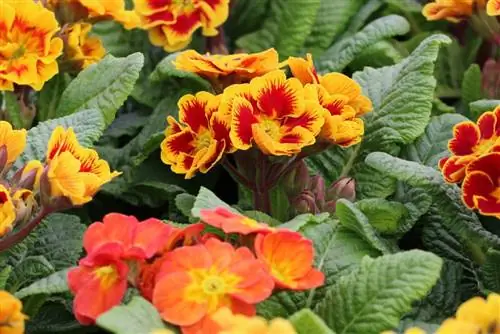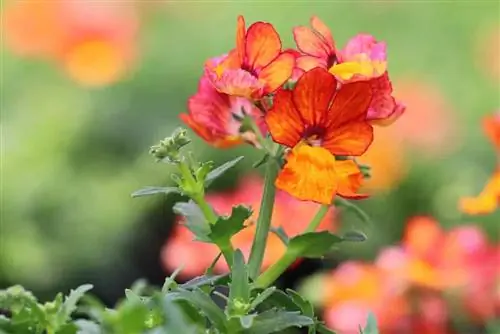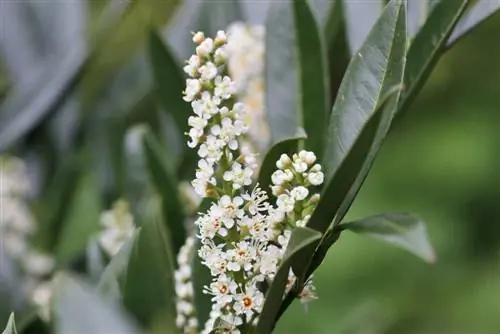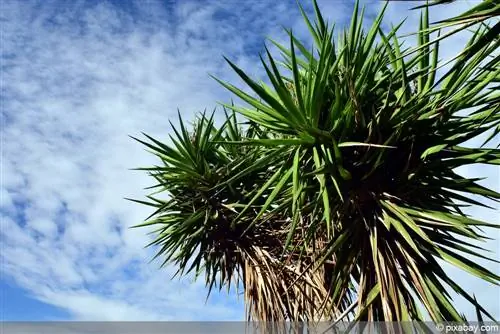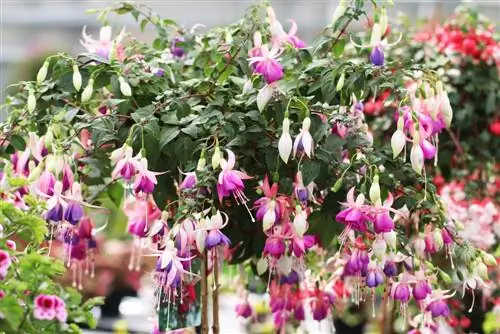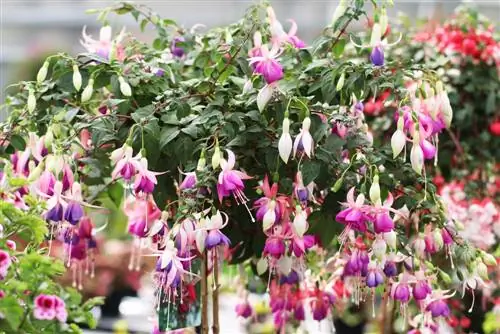- Author admin [email protected].
- Public 2023-12-17 03:39.
- Last modified 2025-06-01 06:48.
There are a number of flowers, shrubs and perennials that can easily survive the winter in the garden. They bring color to the winter garden with their leaves and fruits. If the plants are cultivated in a pot, care in winter is a little more complex. In the right location and with thoughtful precautions, the plants can stay outside even in icy conditions.
hardy
If plants are described as hardy, they can still be damaged. If frost-hardy young plants were repotted before the onset of winter, there is not enough time for them to grow. Subzero temperatures can cause damage to the plant. Even sick plants cannot survive frost without any problems. The hardy plants do not survive if their roots are exposed to frost. Evergreen plants do not slow down their metabolism during the cold months. They need continuous moisture in the substrate so that evaporation via the leaves does not lead to a water deficit.
Winter protection
In particularly harsh and snow-free winter months, you should make sure that the substrate does not freeze. While you can protect the garden floor with a thick layer of mulch, we recommend insulation made of jute bags, foil or garden fleece for pots and balcony boxes. Choose a large plant pot so that after filling, there is as thick a layer of soil as possible up to the inside of the pot. To prevent the cold from moving from the ground into the pot, you can place it on wooden boards or Styrofoam plates. Evergreen balcony plants should not be exposed to direct sunlight in winter as there is a risk of drought stress. In sunny locations you can protect the foliage with a transparent garden fleece.
Tip:
A planter made of fiberglass, zinc or metal can also withstand frost. Terracotta and clay pots are porous and absorb water, which causes the material to burst open after freezing.
Flowers for the balcony box
Not many plants are able to develop flowers during the cold season. The few species among them are specialists that are important not only for the insect world. Early bloomers add color accents when other plants are still in hibernation. Because they require little space, they are ideal for planting in balcony boxes.
Pillow primrose (Primula vulgaris hybrid)
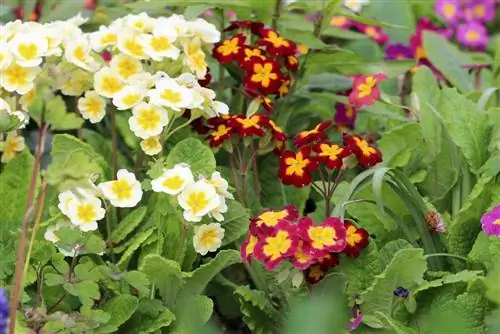
The colorful perennials create an exciting floral fireworks display in the balcony box from January onwards. Their flowering period extends into May. After the flowers have withered, the plant adorns balcony boxes as a foliage perennial. There are annual and perennial varieties. The above-ground plant parts of the perennial specimens die off in autumn. After winter they sprout again. Cushion primroses do not require any care in winter. Make sure that the substrate does not become too moist. Place the bucket in a place directly on the wall of the house that is protected from snow and rain. Watering takes place in January when the first shoots appear. Give the plant a liquid fertilizer so that the flowers are more lush.
- hardy down to -20 degrees Celsius
- grows between five and ten centimeters high
- thrives in cool, partially shaded locations
Evergreen Candytuft (Iberis sempervirens 'Dwarf Snowflake')
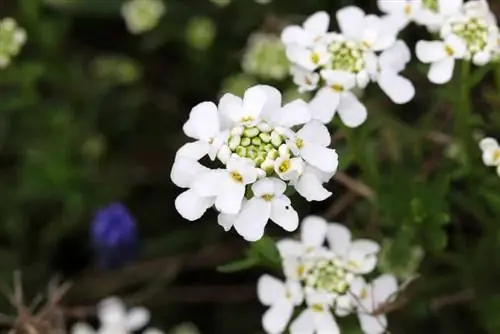
With its compact and cushion-like growth, the candytuft adorns not only rock gardens but also balcony boxes. The dense clumps of leaves on the evergreen plant remain intact throughout the winter months. Their delicate growth makes them the perfect plant for flower boxes. This hardy plant also has no problems with the city climate. Their water requirements are low. The substrate should not dry out completely in winter so that the water cycle is not interrupted. Since the plants do not shed their leaves, moisture evaporates through the leaves even in winter.
- hardy down to -23 degrees Celsius
- Growth height 15 to 20 centimeters
- sunny and rain-protected balconies
Ornamental Cabbage (Brassica oleracea)
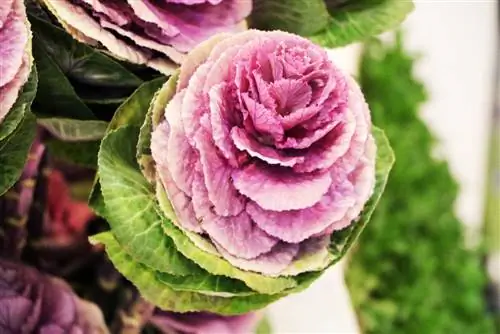
As a hardy plant, this vegetable plant looks good in a flower pot. Ornamental cabbage is a biennial and sets visual accents in the winter garden with its brightly colored rosettes of leaves. The color palette extends from creamy white to yellow to pink in various shades, red and violet. Towards the edge of the leaf the color turns dark or bluish to violet green. The foliage color intensifies until the onset of winter, which is due to the falling temperatures. During the winter, the substrate should not dry out completely, because the cruciferous plants like constant moisture.
- hardy down to -15 degrees Celsius
- Growth height between 30 and 50 centimeters
- prefers sunny locations
Heather Carnation (Dianthus deltoides)
As a native species, the heather carnation is adapted to the cold winter temperatures. Its red, pink or multicolored flowers appear between May and June. The flowering period of the herbaceous plants lasts until November. The stem leaves are narrow lanceolate and silver-green in color. Heather carnations develop dense cushions that decorate rock gardens and dry beds. Because of its manageable height, the plant is perfect for the balcony box. Since the plants require dry substrates with high permeability, you should enrich the planting substrate with gravel, sand or perlite. In winter, make sure that the soil in the pot or bed does not become waterlogged. The roots start to rot easily, allowing diseases to develop.
- hardy down to -40 degrees Celsius
- Growth height between ten and 40 centimeters
- grows in very sunny places
Large-leaved Caucasian forget-me-not (Brunnera macrophylla)
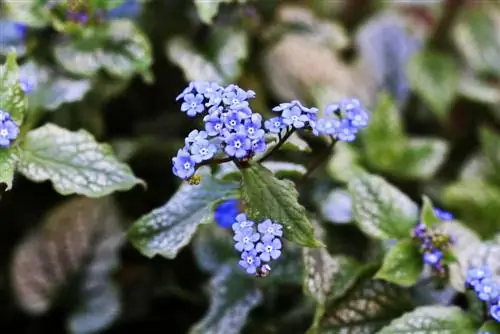
The light blue flowers of the Caucasus forget-me-not are reminiscent of the floral splendor of the local forget-me-not species. They appear between April and June on short-stemmed inflorescences. Fresh flower buds are at risk from late frosts. Cover the plants with a frost protection fleece. The simple leaves of the wild species are lanceolate to oval in shape and green in color. There are attractive cultivated forms with cream-colored leaf edges, heart-shaped leaf blades or silver-spotted leaves. Many varieties have inherited the hardy characteristics of the original plant. It has adapted to the extreme conditions found on the mountain slopes of the Caucasus at altitudes up to 2.000 meters prevail. When winter is just around the corner, the plant stores its energy in rhizomes, which survive in the soil.
- hardy down to -40 degrees Celsius
- grows between 20 and 40 centimeters high
- thrives in sunny and partially shaded places
Plants for the bed
Higher-growing, winter-hardy species are partially suitable for cultivation in buckets. They are better off outdoors, where they rest in the ground during the winter months and sprout again next spring.
Genuine Solomon's Seal (Polygonatum odoratum)
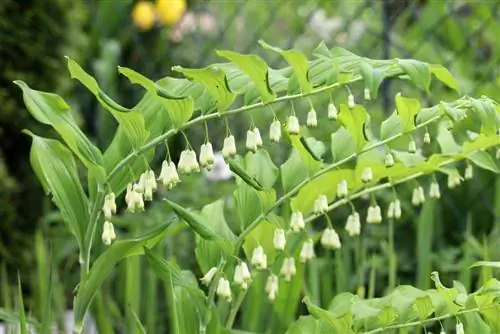
As a plant of deciduous forests, this plant prefers locations with wet conditions. Its creamy white flowers create contrasting accents in dark areas of the garden. The plants develop their flowers from May to June. In autumn, the deep black colored berries create a contrast to the bright yellow leaves. Shortly before the onset of winter, the plant withdraws its energy from the leaf mass to store it in the root nodules. They survive the winter in nature without any problems, as the forest floor is protected from freezing by the fallen leaves.
- hardy to -32 degrees Celsius
- grows between 15 and 50 centimeters high.
- for semi-shady and shady locations
Soft Lady's Mantle (Alchemilla mollis)
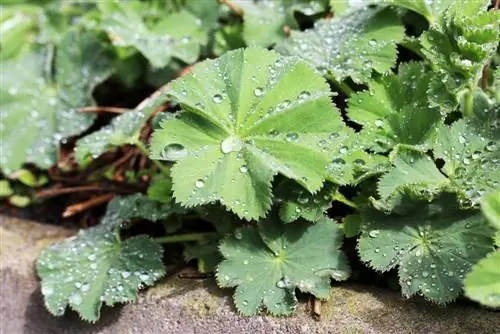
This species, which comes from eastern and southern Europe, beautifies the garden during the growing season with rounded and lobed leaves. Their surface is softly hairy. They create a beautiful picture in rainy times when rainwater rolls off in large drops. The tiny flowers appear in loose inflorescences from June to July. The above-ground parts of the plant die shortly before the onset of winter and lie flat on the ground. They do not need to be removed as they serve as a natural protection against frost. Cut off the remains next spring so that the fresh shoots can develop fully.
- hardy down to -26 degrees Celsius
- Growth height up to 50 centimeters
- prefers light partial shade
Prachtscharte (liatris spicata)
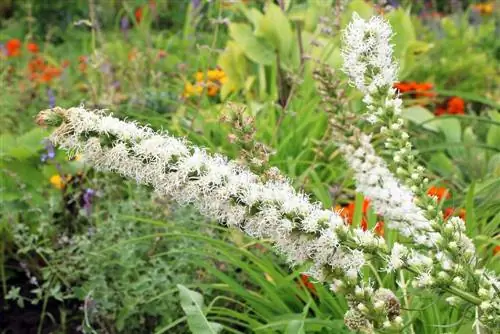
When the purple, pink or white flowers of the magnificent charcoal open in summer, butterflies and wild bees are attracted. The flowers form candle-shaped inflorescences. They open one after the other from top to bottom. The blooms last until September. With their lanceolate leaves, glossy clumps form dense clumps that wilt completely in autumn. They can be cut off shortly before winter or left in the bed. When choosing a location, make sure the soil is well-drained. The root tubers are sensitive to waterlogging. They can rot in winter months that are too wet.
- hardy to - 26 degrees Celsius
- grows between 30 and 100 meters high
- prefers sunny to partially shaded places
Bartweed (Penstemon barbatus)
The plant originally comes from North and South America. Depending on the variety, pink, blue, purple or white flowers open between July and September. Specimens with multicolored petals are particularly decorative. The dark green leaves are elongated and sit opposite each other on the stem axis. Beards need a lot of water during the growth phase. Your roots should not dry out. The leaves of the perennial plants wither in autumn and provide natural protection against ground frost. An additional layer of mulch improves this effect and ensures that the soil does not dry out on sunny days during the cold season. The rhizomes are sensitive to waterlogging. A substrate that is too wet leads to rot in winter.
- hardy down to -20 degrees Celsius
- Growth height 30 to 100 centimeters
- grows in sunny and wind-protected locations
Girl's Eye (Coreopsis verticillata)
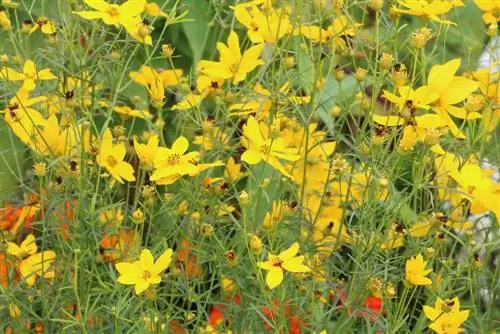
As a prairie plant, the maiden's eye is adapted to warm and dry conditions in summer and frosty temperatures in winter. It forms wiry shoot axes on which delicate and almost needle-shaped leaves emerge. The shoots grow upright and produce a bushy growth habit. The prairie plant begins to bloom in May. It decorates the garden with countless star-shaped flowers that are two to five centimeters tall and are golden yellow in color. Fresh buds sprout regularly until September. The above-ground parts of the plant wither in autumn. They are left standing over the winter and cut off close to the ground in the coming spring so that the fresh shoots get enough light.
- hardy down to -20 degrees Celsius
- grows between 30 and 100 centimeters
- prefers sunny locations

